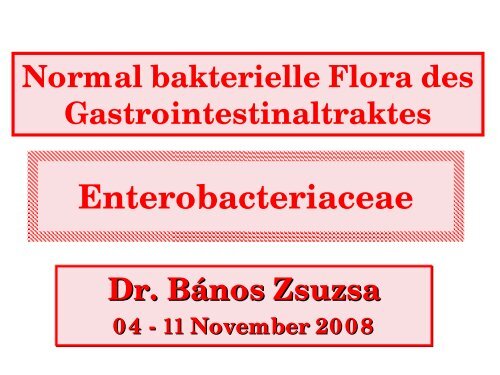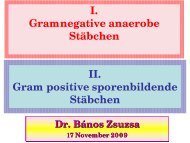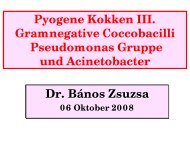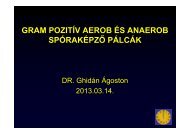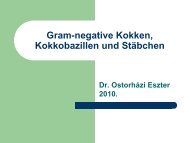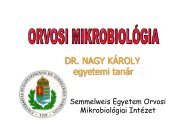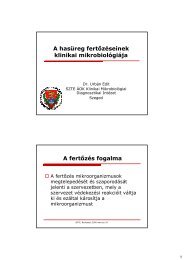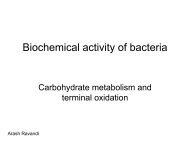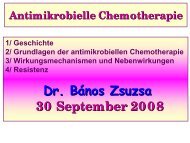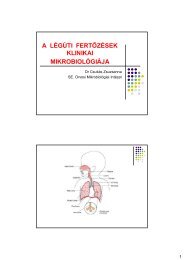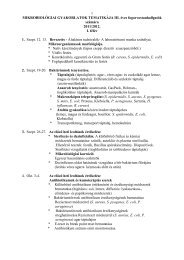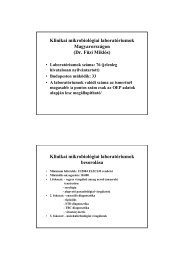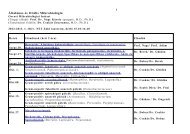Normal bakterielle Flora des Gastrointestinaltraktes
Normal bakterielle Flora des Gastrointestinaltraktes
Normal bakterielle Flora des Gastrointestinaltraktes
You also want an ePaper? Increase the reach of your titles
YUMPU automatically turns print PDFs into web optimized ePapers that Google loves.
<strong>Normal</strong> <strong>bakterielle</strong> <strong>Flora</strong> <strong>des</strong><br />
<strong>Gastrointestinaltraktes</strong><br />
Enterobacteriaceae<br />
Dr. Bános Zsuzsa<br />
04 - 11 November 2008
AEROB<br />
Bordetella<br />
Brucella<br />
Francisella<br />
GRAMNEGATIVE STÄBCHEN<br />
Pseudomonas<br />
Acinetobacter<br />
Legionella<br />
FAKULTATIV ANAEROB<br />
Haemophilus<br />
Pasteurella<br />
Familie:<br />
Enterobacteriaceae<br />
Vibrionaceae<br />
Cardiobacterium<br />
Eikenella<br />
Kingella<br />
Actinobacillus<br />
ANAEROB<br />
Bacteroi<strong>des</strong><br />
Prevotella<br />
Porphyromonas<br />
Fusobacterium<br />
MIKROAEROPHIL<br />
Campylobacter<br />
Helicobacter
<strong>Normal</strong> <strong>bakterielle</strong><br />
<strong>Flora</strong> <strong>des</strong><br />
<strong>Gastrointestinaltraktes</strong>
<strong>Normal</strong> <strong>bakterielle</strong> <strong>Flora</strong> <strong>des</strong><br />
• Bedeutung:<br />
Magen (10 3 –10 6 cfu/g)<br />
<strong>Gastrointestinaltraktes</strong><br />
– säueres pH<br />
– Resident Microflora Ø<br />
– Transient <strong>Flora</strong> +<br />
– Hypochlorhydria, stasis ⇒<br />
Lactobacillus (Boas-Oppler) & Sarcina spp.<br />
• Dünndarm (105 –107 cfu/g)<br />
– Verdauung Enzyme, Galle,<br />
schnelle Peristaltik<br />
– Resident Microflora Ø<br />
– Transient <strong>Flora</strong> +<br />
• Dickdarm (109 –1011 cfu/g)<br />
– Höchste Bakteriendichte Resident Microflora
<strong>Normal</strong> <strong>bakterielle</strong> <strong>Flora</strong> <strong>des</strong> Dickdarmes in<br />
Erwachsenen (>400 Species)<br />
Anaerobe<br />
90–95% der Arten<br />
∼ 10 11 cfu/g im Stuhl<br />
Resident<br />
Bifidobacterium bifidum<br />
Bacteroi<strong>des</strong> fragilis<br />
Eubacterium spp.<br />
Clostridium spp.<br />
Transient<br />
Anaerobe Kokken<br />
Fusobakterien<br />
Lactobacillen<br />
Hahn: Tab.3.2<br />
Fakultativ anaerobe<br />
5–10% der Arten<br />
∼ 10 3 –10 9 cfu/g im Stuhl<br />
Resident<br />
Escherichia coli<br />
Enterococcus spp.<br />
Transient<br />
Klebsiella spp.<br />
Enterobacter spp.<br />
Proteus spp.<br />
Providencia spp.<br />
Pseudomonas spp.<br />
Bacillus spp.<br />
Hefen, Protozoen
<strong>Normal</strong> <strong>bakterielle</strong> <strong>Flora</strong> <strong>des</strong><br />
Dickdarmes der Kinder<br />
• Mit Muttermilch gestillte<br />
Säuglinge<br />
– Resident<br />
• Bifidobakterien (pH 5,5)<br />
– Kolonisierung mit andere Arten ist<br />
gehemmt (Vitamin K Substitution!)<br />
• Mischkost<br />
–Erst<br />
• Fakultativ anaerobe<br />
–Später<br />
• Bacteroi<strong>des</strong> fragilis
Scanning electron micrograph of the colon mucosa<br />
of rat<br />
Magnification: 262× Magnification: 2.624×<br />
⎢: bacterium layer, L: lumen, B: bacteria,<br />
T: intestinal tissue/Darmwand
Bedeutung der normal Darmflora<br />
Abbau von Nahrungsmittel<br />
Bildung von Vitaminen: K & B-Komplex<br />
Gasbildung ⇒ <strong>Normal</strong> Peristaltik<br />
Ständige physische & chemische Stimuli ⇒<br />
ständige Mukosa Turnover<br />
Biofilmbildung, Blockierung von epithelialen<br />
Rezeptoren, Rivalität für Nährstoffe ⇒<br />
Hemmung von Kolonisation pathogener<br />
Bakterien<br />
Ständige Antigenstimulus ⇒ Entwicklung von<br />
Immunsystem<br />
Experimente in keimfreien Tiere
Rolle von normal Bakteriumflora <strong>des</strong><br />
Dickdarmes in pathologischen Prozessen<br />
Extraintestinale Infektionen<br />
Translokation<br />
Immunmangelzustand<br />
Obstruktionen<br />
Shock<br />
Konsequenzen<br />
Endotoxaemie<br />
Bakteriaemie<br />
Sepsis
Bakterielle Translocation nach experimentelle<br />
intestinale Obstruction (Ratte)<br />
A: lifting of the epithelial cells from the<br />
lamina propria & bacterial invasion<br />
B: cocci and rods in<br />
the submucosal lymphatic vessels<br />
A B
Veränderung von Gleichgewicht der<br />
normal Darmflora<br />
• Ursache<br />
– Malnutrition<br />
– Breitspektrum (per os) Antibiotika<br />
• Konsequen onsequenzen<br />
– Maldigestion & Maladsorption, Vitaminmangel<br />
– Veränderung von normal Peristaltik, erhöhte<br />
gastrointestinal Gasbildung<br />
• Antibiotikum<br />
Antibiotikumasso<br />
assoziiert iert Diarrhoe iarrhoe<br />
– Leicht verlaufend: Diarrhoe<br />
– Pseudomembranöse Kolitis<br />
(Clostridium difficile)
Pseudomembranöse Kolitis<br />
Thickened wall of the colon transversum<br />
C. difficile & neutrophils<br />
Characteristic yellow plaques
Gramnegative fakultativ<br />
anaerobe Stäbchen<br />
Enterobacteriaceae
Enterobacteriaceae<br />
Morphologie: - Gram negative Stäbchen<br />
- Geißel<br />
(Ausnahme: Klebsiella, Shigella)<br />
Züchtung:<br />
Einfach, übliche (Agar, Blutagar) Medien<br />
Differenzierung: pathogene-fakultativ pathogene<br />
(Biochemische Leistungen)<br />
a) Selektiv-Medien<br />
b) Differential-Medien<br />
c) Indikator-Medien
Enterobacteriaceae<br />
Antigene und Virulenzfaktoren:<br />
O (Zellwand)<br />
H (Flagella)<br />
K (Kapsel)<br />
Oberflächliche Proteine<br />
Pili<br />
Exotoxine<br />
Endotoxine
Enterobacteriaceae<br />
Fakultativ pathogene<br />
Gattungen<br />
Escherichia<br />
Klebsiella Gruppe<br />
Enterobacter<br />
Edwardsiella<br />
Citrobacter<br />
Proteus Gruppe<br />
Serratia<br />
Providencia<br />
Morganella<br />
Obligat pathogene (Gattungen)<br />
E. Coli<br />
ETEC (enterotoxische)<br />
EPEC (enteropathogene)<br />
EIEC (enteroinvasive)<br />
EHEC (enterohemorrhagische)<br />
EAggEC (enteroaggregativ)<br />
Shigella<br />
S. dysenteriae<br />
S. flexneri<br />
S. boydii<br />
S. sonnei<br />
Salmonella<br />
S. typhi<br />
S. paratyphi<br />
Yersinia<br />
Y. pestis<br />
Y. pseudotuberculosis<br />
Y. enterocolitica
Enterobacteriaceae - Fakultativ Pathogene<br />
Klebsiella, Proteus, Escherichia u. a.<br />
Extraintestinale Krankheitsbilder – eitrige Infektionen:<br />
a) Harnwegsinfektionen<br />
b) Cholecystitis<br />
c) Peritonitis<br />
d) Pneumonie<br />
e) Meningitis<br />
f) Wundinfektionen<br />
g) Sepsis<br />
h) Iatrogene/nosokomiale Infektionen<br />
Diagnose: Isolierung, Identifizierung<br />
Behandlung: Antibiogram (ESBL!)
www.biologie.de<br />
Serratia marcescens - Serratia marcescens Durch Prodigiosin rot<br />
gefärbte Kolonien von Serratia marcescens auf Agargel.
TSI Medium Identifizierung<br />
pathmicro.med.sc.edu
Top row, Proteus vulgaris; second row, unidentified enteric bacterium; third<br />
row, Klebsiella pneumoniae; bottom row, Vibrio alginolyticus.<br />
helios.bto.ed.ac.uk Identifizierung
Harnwegsinfektionen<br />
E. coli 80%<br />
Predisposition<br />
Ascendierend (selten haematogen)<br />
Cystitis, pyelonephritis<br />
Virulenzfaktoren<br />
•(UPEC-Stämme) Haemagglutinierende<br />
Adhäsion-fimbriae<br />
•Mannose resistant (MR) fimbriae (F-antigen),<br />
•P-fimbriae (blood group P substance) ⇒<br />
pyelonephritis<br />
•Mannose sensitive (MS) fimbriae ⇒ cystitis<br />
Haemolysine<br />
www.spiceisle.com<br />
E. coli mit Fimbriae
Harnwegsinfektionen<br />
• P. mirabilis, P. vulgaris<br />
– Predisposition<br />
– Ascendierende Infektion<br />
– Nosokomial (Katheter,<br />
Operation)<br />
– Virulenzfaktoren<br />
• Geissel: Motilität<br />
• Adhäsions-Fimbriae<br />
• Urease Bildung<br />
(pH↑, Irritation,<br />
Nierensteinbildung)<br />
www.sciencebuddies.org<br />
P. mirabilis: Schwärmung
P. mirabilis<br />
Schwärmung<br />
www.nrc-cnrc.gc.ca
Schwärmung<br />
- Auf Zellen<br />
www.nrc-cnrc.gc.ca<br />
P. mirabilis
www.nrc-cnrc.gc.ca<br />
P. mirabilis<br />
Schwärmung<br />
- Auf Zellen
Proteus vulgaris Geissel - Färbung<br />
biology.clc.uc.edu
helios.bto.ed.ac.uk<br />
A: Proteus, Providentia – B: Urease Test - / +
Neugeborene Meningitis & Sepsis<br />
E. coli K1<br />
(80–85%)<br />
K1-Antigen<br />
Identisch mit Meningococcus B-Ag<br />
Toleranz ⇒ kein Antikörper Antwort<br />
Translokation
• Nosokomial<br />
• Predisposition<br />
Pneumonie<br />
• Pathogene<br />
E. coli,<br />
K. pneumoniae,<br />
K. oxytoca,<br />
Enterobacter spp. Bronchopneumonie Lobar pneumonie<br />
(Friedländer)<br />
K. pneumoniae
Klebsiella pneumoniae – Friedländer Pneumonie<br />
www.brown.edu
Klebsiella pneumoniae<br />
Mukoide Kolonien – Kapsel<br />
www.icbm.de
Klebsiella pneumoniae<br />
www.lf3.cuni.cz
Klebsiella pneumoniae
Enterobacter cloacae Klebsiella pneumoniae<br />
Mukoide Kolonien
Intra-abdominale Infektionen<br />
Freie abdominale Luft unter Diaphragma: Perforation<br />
Diffuse Peritonitis nach Colon-Perforation
Enterobacteriaceae<br />
Fakultativ pathogene<br />
Gattungen<br />
Escherichia<br />
Klebsiella Gruppe<br />
Enterobacter<br />
Edwardsiella<br />
Citrobacter<br />
Proteus Gruppe<br />
Serratia<br />
Providencia<br />
Morganella<br />
Obligat pathogene (Gattungen)<br />
Escherichia coli<br />
ETEC (enterotoxisch)<br />
EPEC (enteropathogene)<br />
EIEC (enteroinvasive)<br />
EHEC (enterohemorrhagisch)<br />
EAggEC (enteroaggregativ)<br />
Shigella<br />
S. dysenteriae<br />
S. flexneri<br />
S. boydii<br />
S. sonnei<br />
Salmonella<br />
S. typhi<br />
S. paratyphi<br />
Yersinia<br />
Y. pestis<br />
Y. pseudotuberculosis<br />
Y. enterocolitica
FIGURE 25-1 Virulence mechanisms of E coli.<br />
EAggEC<br />
ETEC<br />
Medmicro<br />
EIEC
FIGURE 25-2 Pathogenesis of E. coli diarrheal disease.<br />
Medmicro
Pathogene E. coli Stämme-1<br />
ETEC (enterotoxisch)<br />
LT (hitzelabiles) ST (hitzestabiles)<br />
ST Wirkung: ADP-Rybosilierung von Guanilcyklase <br />
cGMP Wasser- und Elektrolytverlust<br />
Fimbrien (CFA = colonisation factor antigens)
FIGURE 25-3 Cellular pathogenesis of E coli having CFA pili.<br />
ETEC<br />
Medmicro
ETEC<br />
Fig.4.26 Enterotoxigenic E. coli infection. Transmission electron micrograph<br />
showing bacteria adhering to the brush-border of human intestinal mucosal cells.<br />
By courtesy of Dr. S. Knutton
FIGURE 25-4 Laboratory methods for isolation and<br />
identification of ETEC.<br />
Medmicro
ETEC<br />
Fig. 4.14 Bacterial diarrhea. Y1 adrenal cell assay for E. coli LT enterotoxin,<br />
showing normal cells (left) and cells after exposure to LT toxin (right). Note<br />
disruption of monolayer and rounding up cells. By courtesy of Dr. H.L. DuPont.
Pathogene E. coli Stämme-2-3<br />
EPEC (enteropathogen) O26; O55; O111;<br />
O126…<br />
Adhäsion: Adhärenz Faktor (EAF)<br />
Bundle Forming Pilus (BFP)<br />
Über das Typ III. Sekretionssystem*:<br />
Proteinfilamente (EspA)<br />
Tir (translocated intimin receptor)<br />
Intimin (eae*) Aktinfasern; Po<strong>des</strong>tbildung, Verlust<br />
<strong>des</strong> Bürstensaums Zelltod<br />
* Chromosom kodiert, im Pathogenitätsinsel<br />
EAggEC (enteroaggregativ)<br />
Fimbrien, ST-like, Haemolysin-like Toxin
Fig.4.19 E. coli<br />
diarrhea. Electron<br />
micrograph of<br />
enteropathogenic<br />
E. coli (arrowed)<br />
attached to<br />
mucosal epithelial<br />
cells of ileum. The<br />
microvillus border<br />
of the epithelial<br />
cells has been<br />
largely distroyed<br />
by bacteria and<br />
the cells show<br />
signs of<br />
degeneration.<br />
X3000 By<br />
courtesy of Dr.<br />
J.R. Cantey<br />
EPEC
EPEC<br />
Fig.4.27 Enteropathogenic E. coli infection. Electron micrograph showing close,<br />
localized adherence of bacteria to human intestinal mucosal cells and localized<br />
<strong>des</strong>truction of microvilli. By courtesy of Dr. S. Knutton
EPEC<br />
Fig. 4.28 Enteropathogenic E. coli infection. Fluorescent actin test specific for<br />
EPEC organisms. Left: fluorescent microscopy showing aggregated actin. Right:<br />
phase contrast microscopy showing location of bacteria. By courtesy of dr. S. Knutton
Pathogene E. coli Stämme-4<br />
EIEC (enteroinvasive)<br />
O28; O32; O112; O115; O124, O136; O143, O144 u.a.<br />
Pathogenese:<br />
s. Shigella Proteinen<br />
Typ III. Sekretionssystem
FIGURE 25-5 Cellular pathogenesis of invasive E coli<br />
EIEC
EIEC<br />
Fig. 4.17 Enteroinvasive E. coli infection. Invasion of mucolsal layer of the<br />
intestine by E. coli organisms. There is necrosis of the mucosal layer at the site<br />
of invasion (left). Transmission electron micrograph showing enteroinvasive E.<br />
coli organisms within HEp-2 cell (right). By courtesy of Dr. S. Knutton.
EIEC<br />
Fig. 4.31 Enteroinvasive E. coli infection. EIEC organisms invading<br />
HeLa cells in vitro. By courtesy of Dr. S. Knutton.
Pathogene E. coli Stämme-5<br />
EHEC (enterohemorrhagisch) = VTEC O157:H7<br />
SLT = Verotoxin = Shiga Toxin (stx1, 2, 2c)<br />
Wirkung: hemmt Proteinsynthese zytotoxisch<br />
Haemolysin<br />
Krankheit:<br />
HUS (hämolytische uremisches Syndrom)<br />
Hämolytische Anämie<br />
Trombozytopenie<br />
akute Niereninsuffizienz<br />
Haemorrhagische Kolitis
Pathogene E. coli Stämme<br />
EHEC<br />
(enterohaemorrhagisch)<br />
= VTEC O157:H7<br />
Transmission electron<br />
micrograph of<br />
Escherichia coli<br />
O157:H7<br />
pathmicro.med.sc.edu
EHEC (enterohemorrhagisch) = VTEC O157:H7
Fig. 4.29 Enterohaemorrhagic E. coli infection. Assay for Shiga-like toxin<br />
(Verotoxin) produced by EHEC (Serotype O157). Left: <strong>Normal</strong> monolayer of Vero<br />
cells. Right: Destruction of Vero cells by the toxin. By courtesy of Dr. S. Knutton
Fig. 4.30 Enterohaemorrhagic E. coli infection. Weigert stain showing fibrin<br />
‘thrombi’ in glomerular capillaries in haemolytic uraemic syndrome. By courtesy<br />
of Dr. H.R. Powell
Pathogene E. coli Stämme<br />
Diagnose<br />
Erregernachweis<br />
Serologische Typisierung<br />
Prophylaxe<br />
Expositionsprophylaxe<br />
Behandlung<br />
Ersatz <strong>des</strong> Wasserverlustes<br />
Antibiogram
Gramnegative fakultativ<br />
anaerobe Stäbchen<br />
Enterobacteriaceae II.<br />
Dr. Bános Zsuzsa<br />
04 - 11 November 2008
BAKTERIELLE DARMINFEKTIONEN<br />
I. Typ<br />
Enterotoxin<br />
Hypersekretion<br />
Dünndarm<br />
wäßriger Durchfall<br />
Vibrio cholerae<br />
Escherichia coli<br />
(ETEC)<br />
II. Typ<br />
Inflammation<br />
Invasion in Mucosa<br />
Dickdarm<br />
Eiter, Blut, Schleim im Stuhl<br />
Shigella<br />
E. coli (EIEC) (EPEC, EHEC)<br />
Salmonella<br />
Yersinia enterocolitica<br />
Campylobacter jejuni<br />
Aeromonas sp.<br />
Vibrio parahaemolyticus<br />
Clostridium difficile<br />
Clostridium perfringens<br />
III. Typ<br />
Penetration,<br />
Generalisation<br />
Erreger intrazellulär<br />
Ileum<br />
Typhus, Sepsis<br />
Salmonella typhi<br />
S. paratyphi A, B<br />
Yersinia enterocolitica<br />
Y. pseudotuberculosis<br />
Campylobacter fetus<br />
Exogene, perorale Infektion, fäkal–orale Übertragungsweise
Enterobacteriaceae<br />
Fakultativ pathogene<br />
Gattungen<br />
Escherichia<br />
Klebsiella Gruppe<br />
Enterobacter<br />
Edwardsiella<br />
Citrobacter<br />
Proteus Gruppe<br />
Serratia<br />
Providencia<br />
Morganella<br />
Obligat pathogene (Gattungen)<br />
Escherichia coli<br />
ETEC (enterotoxisch)<br />
EPEC (enteropathogene)<br />
EIEC (enteroinvasive)<br />
EHEC (enterohemorrhagisch)<br />
EAggEC (enteroaggregativ)<br />
Shigella<br />
S. dysenteriae<br />
S. flexneri<br />
S. boydii<br />
S. sonnei<br />
Salmonella<br />
S. typhi<br />
S. paratyphi<br />
Yersinia<br />
Y. pestis<br />
Y. pseudotuberculosis<br />
Y. enterocolitica
Salmonella sp.<br />
www.about-salmonella.com<br />
www.ltsa.fr
Salmonella typhi, S. paratyphi A, B, C<br />
gripsdb.dimdi.de<br />
Menschenpathogene Arten<br />
Antigene<br />
O<br />
H (Geissel)<br />
Oberflächliches Vi Ag<br />
Antigenstruktur von Salmonella typhi
Salmonella typhi, S. paratyphi A, B, C<br />
Pathogenese<br />
Infektionsquelle<br />
Kranke, Ausscheider;<br />
Kontaminierte Lebensmittel, Trinkwasser<br />
Eintrittspforte<br />
Mund Darm Blut Organen: Milz, Leber,<br />
Gallenwege, Knochenmark, Nieren, Gehirn<br />
Ileum: geschwüre (Blutungen, Perforation)<br />
Krankheitsbilder:<br />
Typhus abdominalis<br />
Paratyphus
Salmonella typhi, S. paratyphi A, B, C<br />
Figure 1. Salmonella typhi, the agent<br />
of typhoid. Gram stain. (CDC)<br />
www.textbookofbacteriology.net<br />
Figure 2. Flagellar stain of a Salmonella<br />
Typhi. Like E. coli, Salmonella are motile<br />
by means of peritrichous flagella. A close<br />
relative that causes enteric infections is<br />
the bacterium Shigella. Shigella is not<br />
motile, and therefore it can be<br />
differentiated from Salmonella on the bais<br />
of a motility test or a flagellar stain. (CDC)
Typhus abdominalis<br />
Roseolenartiges, makulopapulöses Exanthem bei<br />
Typhus abdominalis<br />
gripsdb.dimdi.de
www.wrongdiagnosis.com<br />
Rose spots on abdomen of a patient with typhoid fever<br />
due to the bacterium Salmonella typhi.
Rose spots on the chest of a patient with typhoid fever<br />
due to the bacterium Salmonella typhi. www.wrongdiagnosis.com
Fig. 4.37 Typhoid fever. Numorous ulcers of the small intestine<br />
overlying hyperplastic lymphoid follicles (Peyer’s patches). By courtesy<br />
of Dr. J. Newman.
Fig. 4.39 Typhoid fever. Mononuclear cells and red blood cells in the<br />
stool. Trichrome stain. By courtesy of Dr. H.L. DuPont.
Typhus abdominalis<br />
Diagnose<br />
Erregernachweis (Blut, Stuhl, Urine)<br />
Selektivmedien<br />
Antikörpernachweis (Agglutination)<br />
Prophylaxe<br />
Expositionsprophylaxe<br />
Immunprophylaxe:<br />
1) Aktive orale Immunisierung mit<br />
Ty21, einem apathogenen,<br />
abgeschwächten Stamm<br />
2) Parenterale Impfung mit Vi<br />
Kapselpolysaccharid<br />
S. typhi-Stamm Typ-2<br />
Therapie<br />
Ampicillin<br />
Trimethoprim<br />
Chloramphenikol<br />
Sanierung der<br />
Dauerausscheider!<br />
„Typhoid Mary”<br />
www.spiceisle.com
Salmonella - Salmonellosis<br />
Ubiquitär S. typhimurium, S. enteritidis u.a<br />
Pathogen für Geflügel, Eier, Schwein, Rind, Mäuse, Ratte und<br />
Menschen<br />
Pathogenese<br />
Infektionsquelle: Infizierte tierische, kontaminierte Lebensmittel<br />
Bakterien vermehren sich im Lebensmittel Endotoxin wird frei<br />
Krankheitsbild: (Gastro)Enteritis – Endotoxin Wirkung<br />
Keimausscheidung ist kurz<br />
Diagnose: Erregernachweis (Stuhl, Speiseresten)<br />
Prophylaxe: Lebensmittel und Küchenhygiene
Figure 21-3 Invasion of intestinal mucosa by Salmonella.<br />
medmicro
www.idph.state.il.us
Salmonella sp.<br />
spacescience.com
www.arches.uga.edu<br />
Salmonella sp.
www.textbookofbacteriology.net<br />
Salmonella enterica<br />
www2.nphs.wales.nhs.uk
Figure 3.<br />
Salmonella sp. after<br />
24 hours growth on<br />
XLD agar.<br />
www.textbookofbacteriology.net
Figure 4. Colonial growth Salmonella choleraesuis<br />
subsp. arizonae bacteria grown on a blood agar<br />
culture plate. Also known as Salmonella Arizonae, it<br />
is a zoonotic bacterium that can infect humans,<br />
birds, reptiles, and other animals. (CDC)<br />
www.textbookofbacteriology.net
Rambach Agar<br />
For detection of Salmonella spp.<br />
•Salmonella -red<br />
•other bacteria - blue, violet,<br />
colourless, or inhibited.<br />
www.chromagar.com<br />
Isolation of Salmonella<br />
from Environmental<br />
Samples<br />
wqc.arizona.edu
TSI Medium Identifizierung<br />
pathmicro.med.sc.edu
Salmonella typhimurium HE agar<br />
www.textbookofbacteriology.net
Enterobacteriaceae<br />
Fakultativ pathogene<br />
Gattungen<br />
Escherichia<br />
Klebsiella Gruppe<br />
Enterobacter<br />
Edwardsiella<br />
Citrobacter<br />
Proteus Gruppe<br />
Serratia<br />
Providencia<br />
Morganella<br />
Obligat pathogene (Gattungen)<br />
Escherichia coli<br />
ETEC (enterotoxisch)<br />
EPEC (enteropathogene)<br />
EIEC (enteroinvasive)<br />
EHEC (enterohemorrhagisch)<br />
EAggEC (enteroaggregativ)<br />
Shigella<br />
S. dysenteriae<br />
S. flexneri<br />
S. boydii<br />
S. sonnei<br />
Salmonella<br />
S. typhi<br />
S. paratyphi<br />
Yersinia<br />
Y. pestis<br />
Y. pseudotuberculosis<br />
Y. enterocolitica
Shigella<br />
S. dysenteriae* 10 Serotyp<br />
S. flexneri* 6 Serotyp<br />
S. boydii 15 Serotyp<br />
S. sonnei<br />
Antigene<br />
O<br />
* Toxinbilder<br />
Shigella sonnei
Shigella<br />
Virulenzfaktoren<br />
Exotoxin<br />
Zytotoxische (Zellyse!);<br />
Enterotoxische;<br />
Paralytische – letale Aktivität<br />
Fragment A, B (5) – Glykolipid<br />
<br />
Hemmung der Proteinsynthese durch Bindung und<br />
Inaktivation von 60s Ribosom Untereinheit Zelltod<br />
OMP (Ipa, Ics)<br />
Endotoxin - LPS
Shigella<br />
Pathogenität – ID50: 100-200 Bakterien<br />
Eindringen und Vermehrung in Epithelzellen:<br />
Invasion Plasmid Antigens – Ipa<br />
Intercellular Spread – Ics<br />
Pathogenese, Krankheitsbilder<br />
Lokale Infektion<br />
Epithelnekrose, Geschwürbildung<br />
Hemmung von Absorption<br />
HUS!
Shigella<br />
Medmicro
Shigella<br />
mgc.ac.cn/VFs/Figures/Shigella
Fig. 2: Shigella Passing Through the<br />
Mucous Membrane and …<br />
… Invading Mucosal<br />
Epithelial Cells<br />
faculty.ccbcmd.edu
Fig. 4.34 Shigellosis.<br />
Sigmoidiscopic view of colonic<br />
mucosa in a fatal case of<br />
infection with S. dysenteriae<br />
type 1 showing extensive<br />
pseudomembranous colitis. By<br />
courtesy of Dr. R.H. Gilman<br />
and Dr. F. Koster.<br />
Fig. 4.33 Shigellosis.<br />
Sigmoidiscopic view of colonic<br />
mucosa in a mild case of infection<br />
due to S. flexneri. Note the thin<br />
whitish exsudate, which is made up<br />
of fibrin and polymorphonuclear<br />
leucocytes. By courtesy of Dr. R.H.<br />
Gilman.
Fig. 4.18 Positive Serény test. Keratoconjunctivitis in the rabbit<br />
produced by the instillation of shigella microorganism. By courtesy of<br />
Dr. H.L. DuPont.
Shigella<br />
Diagnose<br />
Erregernachweis<br />
(aus dem Stuhl)<br />
Differenzierung –<br />
Selektiv<br />
Medien<br />
Identifizierung<br />
Serotypisierung<br />
www.textbookofbacteriology.net
TSI Medium Identifizierung<br />
pathmicro.med.sc.edu
Shigella boydii Kolonien auf Blutagar<br />
www.biologie.de
Appearance of Colonies on Salmonella-Shigella Agar<br />
D: Proteus mirabilis<br />
A. Klebsiella pneumoniae<br />
Klebsiella pneumoniae &<br />
Escherichia coli are positive<br />
for acid production from<br />
fermentation of the<br />
carbohydrate(s) present.<br />
C: Salmonella sp.<br />
Both Salmonella<br />
sp. & Proteus<br />
mirabilis product<br />
hydrogen sulfide.<br />
B. Escherichia coli<br />
E: Pseudomona aeruginosa<br />
The Pseudomonas colonies are nearly colorless.<br />
www.rci.rutgers.edu
Shigella<br />
Prophylaxe<br />
Expositionsprophylaxe – Verbesserung der Hygiene<br />
Therapie<br />
Antibiogram<br />
Tetracylin, Ampicillin, Chloramphenicol, Sumetrolim
Enterobacteriaceae<br />
Fakultativ pathogene<br />
Gattungen<br />
Escherichia<br />
Klebsiella Gruppe<br />
Enterobacter<br />
Edwardsiella<br />
Citrobacter<br />
Proteus Gruppe<br />
Serratia<br />
Providencia<br />
Morganella<br />
Obligat pathogene (Gattungen)<br />
Escherichia coli<br />
ETEC (enterotoxisch)<br />
EPEC (enteropathogene)<br />
EIEC (enteroinvasive)<br />
EHEC (enterohemorrhagisch)<br />
EAggEC (enteroaggregativ)<br />
Shigella<br />
S. dysenteriae<br />
S. flexneri<br />
S. boydii<br />
S. sonnei<br />
Salmonella<br />
S. typhi<br />
S. paratyphi<br />
Yersinia<br />
Y. pestis<br />
Y. pseudotuberculosis<br />
Y. enterocolitica
Yersinia enterocolitica<br />
Morphologie Gramnegative,<br />
bipolare Stäbchen<br />
Geissel<br />
www.wadsworth.org
Yersinia enterocolitica<br />
Kultur<br />
Wachstumoptimum 28°C, Beweglich auch bei 28°C<br />
www.szu.cz<br />
Blutagar<br />
Antigene<br />
O und H<br />
www.ktl.fi<br />
Y. enterocolitica<br />
O:5,27 CIN-ag
Y. enterocolitica<br />
de.wikipedia.org
Figure 29-7 Pathogenesis of Y. enterocolitica.<br />
Krankheitsbilder<br />
Enterocolitis<br />
Lymphadenitis mesenterica<br />
Diagnose<br />
Erregernachweis<br />
Serologie<br />
Serotypisierung<br />
Therapie<br />
Tetracyclin<br />
Chloramphenicol<br />
Sumetrolim
Yersinia pseudotuberculosis<br />
Morphologie<br />
Gramnegative, bipolare Stäbchen<br />
Geissel<br />
Kultur<br />
Leicht, Wachstum 37°C und 20°C<br />
Beweglichkeit bei 20°C<br />
Pathogenität<br />
Pseudotuberculosis von<br />
Nagetieren<br />
www.microbes-edu.org<br />
Infektionsquelle:<br />
Kranke Tiere<br />
Eintrittspforte: Mund, Schleimhäute Y. pseudotuberculosis
Yersinia pseudotuberculosis<br />
Krankheitsbilder<br />
Lymphadenitis mesenterica<br />
Septische-typhöse Form<br />
Enteritis<br />
Diagnose<br />
Erregernachweis<br />
Serotypisierung – Agglutination<br />
Serologie<br />
Therapie<br />
Tetracyclin
Fig. 4.50 Yersinia infection. Gross specimen of ileum, showing superficial necrosis of the<br />
intestinal musosa with several weel-defined deep and superficial ulcers.
Y. pseudotuberculosis<br />
www.llnl.gov
Gramnegative<br />
fakultative anaerobe<br />
Stäbchen<br />
Vibrionaceae
AEROB<br />
Bordetella<br />
Brucella<br />
Francisella<br />
GRAMNEGATIVE STÄBCHEN<br />
Pseudomonas<br />
Acinetobacter<br />
Legionella<br />
FAKULTATIV ANAEROB<br />
Haemophilus<br />
Pasteurella<br />
Familie:<br />
Enterobacteriaceae<br />
Vibrionaceae<br />
Cardiobacterium<br />
Eikenella<br />
Kingella<br />
Actinobacillus<br />
ANAEROB<br />
Bacteroi<strong>des</strong><br />
Prevotella<br />
Porphyromonas<br />
Fusobacterium<br />
MIKROAEROPHIL<br />
Campylobacter<br />
Helicobacter
BAKTERIELLE DARMINFEKTIONEN<br />
I. Typ<br />
Enterotoxin<br />
Hypersekretion<br />
Dünndarm<br />
wäßriger Durchfall<br />
Vibrio cholerae<br />
Escherichia coli<br />
(ETEC)<br />
II. Typ<br />
Inflammation<br />
Invasion in Mucosa<br />
Dickdarm<br />
Eiter, Blut, Schleim im Stuhl<br />
Shigella<br />
E. coli (EIEC) (EPEC, EHEC)<br />
Salmonella<br />
Yersinia enterocolitica<br />
Campylobacter jejuni<br />
Aeromonas sp.<br />
Vibrio parahaemolyticus<br />
Clostridium difficile<br />
Clostridium perfringens<br />
III. Typ<br />
Penetration,<br />
Generalisation<br />
Erreger intrazellulär<br />
Ileum<br />
Typhus, Sepsis<br />
Salmonella typhi<br />
S. paratyphi A, B<br />
Yersinia enterocolitica<br />
Y. pseudotuberculosis<br />
Campylobacter fetus<br />
Exogene, perorale Infektion, fäkal–orale Übertragungsweise
Vibrionaceae<br />
Gramnegative fakultativ anaerobe Stäbchen<br />
(Positive Glucose fermentation)<br />
Oxidase positive Oxidase negative<br />
Aeromonadaceae<br />
Vibrio Plesiomonas Aeromonas<br />
V. cholerae<br />
V. parahaemolyticus<br />
V. vulnificus<br />
P. shigelloi<strong>des</strong> A. hydrophila<br />
Facultative<br />
pathogenic<br />
Escherichia<br />
Klebsiella<br />
Enterobacter<br />
Proteus<br />
Serratia<br />
Providencia<br />
Morganella<br />
Edwardsiella<br />
Citrobacter<br />
Hafnia<br />
Enterobacteriaceae<br />
Obligate<br />
pathogenic<br />
Salmonella<br />
Shigella<br />
Yersinia
Vibrionaceae<br />
Species Krankheiten<br />
V. cholerae O1<br />
klassische & El Tor<br />
Cholera<br />
V. cholerae O139 Cholera<br />
V. parahaemolyticus Gastroenteritis<br />
V. vulnificus Wundinfektion, Sepsis<br />
Non-agglutinable<br />
(NAG) vibrios<br />
Gastroenteritis
Vibrio cholerae<br />
R. Koch, 1883<br />
Morphologie<br />
Gramnegative, gekrümmte<br />
Stäbchen<br />
Fakultativ anaerobe<br />
Biochemische Leistungen<br />
Glukose OF ‡<br />
Bewegung +<br />
Katalase +<br />
Oxidase +<br />
Nitrat Reduction +
V. cholerae<br />
bepast.org
V. cholerae<br />
Antigenstruktur<br />
O (Zellwand) - 138<br />
O1 & O139<br />
H Geissel (gemeinsam)<br />
Fimbriae: A, B, C<br />
O1: Bio und Serotypen
Vibrio cholerae. Leifson flagella stain (digitally colorized). CDC/Dr.<br />
William A. Clark<br />
pathmicro.med.sc.edu
Bio- & Serotypen von V. cholerae O1<br />
Medmicro
Virulenzfaktoren<br />
Virulenzfaktor Biologische Effekt<br />
Choleratoxin (Enterotoxin)<br />
Hypersekretion von Wasser und<br />
Elektrolyten<br />
Fimbrien Adhäsion – Mucus Membran<br />
Accessory colonisation factor<br />
(ACF)<br />
Haemagglutination Protease<br />
(Mucinase)<br />
Neuraminidase<br />
Adhäsion – Mucus Membran<br />
Schleim Hydrolyse<br />
Überregulation von Toxin-<br />
Rezeptor
V. cholerae<br />
Pathogenese – Obligat Menschenpathogen<br />
Infektionsquelle: 1. Kranke Menschen und Ausscheider<br />
(Inkubations-, Dauerausscheider und Rekonvalenscente<br />
– durch Stuhl! – Fliege!)<br />
2. Kontaminierte Lebensmittel (Seespeise!) und<br />
Trinkwasser<br />
Reservoir: Algen, Muscheln, Plakton<br />
Übertragung: Perorale Infektion<br />
Eintrittspforte: Magen-Darmtrakt<br />
Toxinbildung in Dünndarm<br />
Keine Ausbreitung!<br />
Krankheit: Kolera – durch Choleratoxin<br />
Immunität: lokal IgA (IgG im Blut)
Adhäsion von V. cholerae
FIGURE 24-1 Pathophysiology of cholera.<br />
Medmicro ch 24
textbookofbacteriology.net<br />
Cholera toxin: Wirkungsmechanism
1. 2.<br />
3.<br />
4.<br />
www.ebi.ac.uk
Cholera Toxin und Pertussis Toxin
Cholera Pandemien<br />
• Indien, Mündung von Ganges<br />
• Interkontinentale Reisen, Handelsverkehr, Kriege<br />
⇒ 7 Pandemien ab 1817<br />
• Jetzt: 7. Pandemie, V. EL Tor<br />
– 1961: Asien<br />
– 70’s–80’s: Afrika, Europa, Oceania<br />
– 1991: Süd-Amerika<br />
• 1992 : V. cholerae O139 „Bengal”<br />
– Schnelle Ausbreitung (Asien, Europa, USA)<br />
– Keine Kreuzimmunität mit O1-Stämme<br />
– 8. Pandemie?
7. Cholera Pandemie 1961
Cholera Erkrankungen, WHO: 2000–2001
Cholera Ausbruch<br />
Cholera camp in Mozambique<br />
Cholera clinic in Mozambique
• Wässrige Durchfall<br />
(25 L/day)<br />
• Dehydration<br />
• Haemokoncentration<br />
• Blut pH <br />
• Serum K + , Na + <br />
• Serum Glucose ↑<br />
• Shock<br />
• Letalität<br />
– Unbehandelte<br />
• Klassisch: 60%<br />
• El Tor: 15–30%<br />
– Behandelte: 1%<br />
Cholera: Klinik<br />
Vor und nach<br />
Rehydration<br />
Rice-water diarrhoea ; Reiswasser Stühle
Cholera Bette
Diagnose<br />
• ANAMNESE!<br />
• Untersuchungsmaterial:<br />
Stuhl<br />
• Erregernachweis:<br />
Dunkelfeld Mikroskopie
Diagnose<br />
Transport: Alkalische Peptonwasser<br />
Kultur: TCBS Nährmedium
Diagnose<br />
Identifizierung<br />
Biochemische Reaktionen<br />
Serotypisierung (O1, O139)<br />
Antibiogram
V. cholerae<br />
Prophylaxe von Kolera<br />
Expositionsprophylaxe<br />
Verbesserung der Trinkwasser– und<br />
Lebensmittelhygiene und der Abwasserbeseitigung<br />
Massenerziehung von hygienischen Massnahmen<br />
Isolierung; Quarantäne<br />
Ausheilung, Desinfektion<br />
Abkochen <strong>des</strong> Wassers<br />
Kontrolle der Ausscheider<br />
WHO Meldepfilcht
• Immunprophylaxe<br />
Vaccination<br />
– Schutzimpfung (nur gegen O1)<br />
• Inaktivierte Bakterien, parenterale<br />
• Inaktivierte Bakterien + B-subunit Toxoid per os<br />
• Genmanipulierte, attenuierte V. cholerae per os<br />
– Immunität dauert 3–6 Monate, Effektivität 50–<br />
60%<br />
– Reisende<br />
– WHO: falsches Sicherheitsgefühl (!)
Massenerziehung von hygienischen<br />
Massnahmen
Therapie von Cholera<br />
Salt-sticks<br />
Coke
Therapie von Cholera<br />
• Ersatz von Wasser und<br />
Elektrolyte<br />
– Intravenös<br />
– Per os Oral Rehydration Fluid<br />
ORF<br />
• Glucose 20g/l<br />
• NaHCO3: 2,5 g/l<br />
• NaCl: 3,5 g/l<br />
• KCl: 1,5 g/l<br />
• Antibiotika<br />
– Ciprofloxacin<br />
– Doxycycline<br />
Bangla<strong>des</strong>h<br />
Peru
Vibrio parahaemolyticus<br />
www.city.niigata.niigata.jp
Gastroenteritis<br />
www.fehd.gov.hk
V. vulnificus<br />
Fig. 10.20 Cellulitis. Severe infection with bullous lesions due to V.<br />
vulnificus infection following immersion of leg in brackish water.
V. vulnificus<br />
Fig. 10.21 Vibrio<br />
cellulitis. Haemorrhagic,<br />
bullous lesions of V.<br />
vulnificus sepsis. By<br />
courtesy of Dr. J.R.<br />
Cantey
A. hydrophila P. shigelloi<strong>des</strong><br />
A. hydrophila infection in fish<br />
Cellulitis Myonecrosis<br />
web.umr.edu<br />
Natural water sources<br />
Sea food<br />
Gastroenteritis
Aeromonas hydrophila<br />
www.buddycom.com
Aeromonas hydrophila<br />
http://www.vetmed.wisc.edu<br />
web.umr.edu<br />
Plesiomonas shigelloi<strong>des</strong><br />
www.buddycom.com
Aeromonas hydrophila
Aeromonas hydrophila
I.<br />
Gramnegative spiralförmige<br />
und gekrümmte Stäbchen<br />
Gramnegative anaerobe<br />
Stäbchen<br />
Dr. Bános Zsuzsa<br />
04 - 11 November 2008
1. Microaerophile –<br />
Campylobacter und<br />
Helicobacter
BAKTERIELLE DARMINFEKTIONEN<br />
I. Typ<br />
Enterotoxin<br />
Hypersekretion<br />
Dünndarm<br />
wäßriger Durchfall<br />
Vibrio cholerae<br />
Escherichia coli<br />
(ETEC)<br />
II. Typ<br />
Inflammation<br />
Invasion in Mucosa<br />
Dickdarm<br />
Eiter, Blut, Schleim im Stuhl<br />
Shigella<br />
E. coli (EIEC) (EPEC, EHEC)<br />
Salmonella<br />
Yersinia enterocolitica<br />
Campylobacter jejuni<br />
Aeromonas sp.<br />
Vibrio parahaemolyticus<br />
Clostridium difficile<br />
Clostridium perfringens<br />
III. Typ<br />
Penetration,<br />
Generalisation<br />
Erreger intrazellulär<br />
Ileum<br />
Typhus, Sepsis<br />
Salmonella typhi<br />
S. paratyphi A, B<br />
Yersinia enterocolitica<br />
Y. pseudotuberculosis<br />
Campylobacter fetus<br />
Exogene, perorale Infektion, fäkal–orale Übertragungsweise
Spiral formed & curved<br />
Gram-negative bacteria<br />
Spirillaceae<br />
Campylobacter Helicobacter Spirillum<br />
C. jejuni H. pylori S. minus
Wichtigste Arten von Campylobacter<br />
Species Reservoir Krankheit Häufigkeit<br />
C. jejuni<br />
C. coli<br />
Geflügel,<br />
Schwein, Rind,<br />
Hase<br />
Geflügel,<br />
Schwein, Rind,<br />
Schaf<br />
C. fetus Rind, Schaf<br />
C. lari<br />
Geflügel,<br />
Schwein, Katze,<br />
Affe, Pferd<br />
C. upsalensis Hund, Katze<br />
Gastroenteritis,<br />
Sepsis,<br />
Meningitis,<br />
Guillan-Barré<br />
Sepsis,<br />
Gastroenteritis,<br />
Meningitis<br />
Sepsis,<br />
Gastroenteritis,<br />
Meningitis<br />
Gastroenteritis,<br />
Sepsis<br />
Gastroenteritis,<br />
Sepsis, Abszess<br />
Häufig<br />
Selten<br />
Selten<br />
Selten<br />
?
Campylobacter<br />
Morphologie<br />
Gramnegative<br />
gekrümmte Stäbchen<br />
(0,3–0,6 μm)
Campylobacter<br />
Geissel<br />
www.shef.ac.uk<br />
www.wadsworth.org<br />
Transmission electron<br />
micrographs of<br />
Campylobacter jejuni,<br />
negatively stained to<br />
enhance contrast.<br />
Campylobacter jejuni
Campylobacter jejuni<br />
www.indigo.com
Campylobacter<br />
Kultur<br />
Microaerophil<br />
5–7% O 2<br />
5–10% CO 2<br />
Thermophil: 42ºC<br />
Campy-blood-agar<br />
medinfo.ufl.edu
Spezielle Medien<br />
www.biomerieux.com
Campylobacter<br />
Biochemie<br />
Nichtfermentierend<br />
• Katalase +, Oxidase +<br />
• Nitratreduktion +<br />
• Antigen Struktur<br />
–O, H, K<br />
(Serotypisierung)<br />
C. jejuni, SEM<br />
C. jejuni, SEM
Campylobacter<br />
Virulenzfaktoren<br />
• Geissel ⇒ Bewegung<br />
• Adhäsion Faktoren<br />
• Invasion Faktoren (?)<br />
• Zytotoxin<br />
• C. fetus: S-Proteinhülle ⇒ Hemmung von C3b Bindung<br />
⇒ Antiphagozytose<br />
• LPS<br />
Komplikation:<br />
• Guillan-Barré Syndrom<br />
Strukturähnlichkeit: Kernoligosaccharide <strong>des</strong> LPS mit<br />
Gangliosiden im Nervensystem (GM1, GM2)<br />
⇒Antikörper gegen GM1 ⇒ Autoimmunprozess ⇒<br />
Demyelinisierung
C. coli & Guillan-Barré syndrome
Epidemiologie<br />
• Zoonose!<br />
• Infektionsquelle:<br />
Kontaminierte Lebensmittel &<br />
Wasser<br />
• Mensch zu Mensch: Fäkal-oral<br />
Übertragung (Kinder). Selten<br />
• ID: 500<br />
• Häufig in tropischen,<br />
subtropischen Ländern (80%)
Campylobacteriosis: Klinik<br />
• Inkubation: 1–2 Tage<br />
• Blutige Durchfälle<br />
• Fieber<br />
• Abdominale Schmerzen,<br />
Krämpfe<br />
• Spontan Ausheilung:<br />
1–7 Tage<br />
• Komplikationen<br />
– Protahierte Verlauf<br />
– Systemische Infektion<br />
– Reaktiv Arthritis<br />
– Guillan-Barré Syndrome<br />
(Polyneuropathie)
Diagnose von Campylobacter Infektionen<br />
• Untersuchungsmaterial<br />
–Stuhl<br />
– Blutkultur, Liquor<br />
– Lebensmittel<br />
• Kultur<br />
(Mikroaerophil!, Thermophil!)<br />
• Identifizierung<br />
• Antibiogram<br />
Biochemical identification<br />
Campylo-agar<br />
culture
Therapie & Prevention von<br />
Campylobacter Infektionen<br />
• Wasser und Elektrolytsubstitution<br />
• Antibiotika<br />
– Gastroenteritis<br />
• Erythromycin, Doxycycline, Ciprofloxacin,<br />
Amoxicillin/Klavulansäure<br />
– Systemische Infektionen<br />
• Carbapenem, Aminoglycoside, Chloramphenicol<br />
• Prevention: Lebensmittelhygiene
Morphologie<br />
• Gramnegative, spiralförmige<br />
Stäbchen<br />
Geissel: Motilität<br />
Kultur<br />
• Microaerophil<br />
Biochemie<br />
• Non-fermenting<br />
• Katalase +<br />
• Oxidase +<br />
• Urease + (!)<br />
Helicobacter pylori<br />
H. pylori
Virulenzfaktoren von H. pylori<br />
• Adhäsine (HOP)<br />
• Flagella (Motilität)<br />
• Urease Aktivität<br />
• Vacuolisieren<strong>des</strong> Zytotoxin<br />
• Protein CagA<br />
Translokation durch<br />
Typ IV. Sekretionssystem<br />
Veränderung von Zytoskelet<br />
Il-8, Il-1, TNFα Stimulation<br />
Urease positiv<br />
Cytotoxic effect in HeLa cells
Epidemiologie und Klinik von<br />
Epidemiologie<br />
• Weltweit verbreitet<br />
• Reservoir: Mensch<br />
• Übertragung<br />
– Fäkal-oral<br />
– Oro-oral (Speichel)<br />
– Endoskop!<br />
H. pylori Infektionen<br />
Klinik<br />
Akut Gastritis<br />
Chronisch-aktive Gastritis<br />
Gastroduodenale Ulcuskrankheit<br />
Tumorbildung
H. pylori & Magengeschwür<br />
H. pylori on gastric mucosa, SEM<br />
H. pylori histology, silver impregnation<br />
Chronic gastritis<br />
Duodenal ulcer
H. pylori & Tumorbildung<br />
Antral adenocarcinoma<br />
gastroscopic finding<br />
Gastric adenocarcinoma with<br />
liver metastasis & ascites
Diagnose von H. pylori<br />
• Nachweis von Helicobacter Antigen im Stuhl<br />
• Magenbiopsie: Histopathologischer, kultureller,<br />
molekulargenetischer Nachweis<br />
• Radioaktiv Urea Atemtest (Urease Nachweis)<br />
• Antikörper Nachweis
Radioaktiv Urea Atemtest
Mikrobiologische Diagnose von<br />
Antikörpernachweis – Blutserum<br />
H. pylori ELISA (IgG, IgA)<br />
H. pylori Western blot<br />
H. pylori<br />
Erregernachweis –<br />
Biopsie Material<br />
H. pylori culture<br />
Biochemical identification
H. pylori Eradikation<br />
• Kombinations - Therapie mit<br />
– Protonenpumpenhemmer<br />
– Antibiotika<br />
• Clarithromycin + Metronidazole<br />
• Amoxicillin + Metronidazole<br />
• Doxycycline + Metronidazole<br />
– Eradikation: 90% der Fälle
Zakynthos, 2004<br />
ENDE


